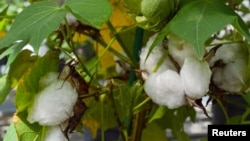U.S. regulators have cleared the way for farmers to grow a cotton plant genetically modified to make the cottonseed edible for people, a protein-packed potential new food source that could be especially useful in cotton-growing countries beset with malnutrition.
The U.S. Department of Agriculture Animal and Plant Health Inspection Service on Tuesday lifted the regulatory prohibition on cultivation by farmers of the cotton plant, which was developed by Texas A&M University scientists. The plant’s cottonseed cannot be used as food for people or as animal feed yet in the United States because it lacks Food and Drug Administration approval.
Cotton is widely grown around the world, with its fiber used to make textiles and the cottonseed used among other things to feed animals such as cattle and sheep that have multiple stomach chambers. Ordinary cottonseed is unfit for humans and many animals to eat because it contains high levels of gossypol, a toxic chemical.
With financial help from a cotton industry group, scientists led by Texas A&M AgriLife Research plant biotechnologist Keerti Rathore used so-called RNAi, or RNA interference, technology to “silence” a gene, virtually eliminating gossypol from the cottonseed. They left gossypol at natural levels in the rest of the plant because it guards against insects and disease.
“To me, personally, it tastes somewhat like chickpea and it could easily be used to make a tasty hummus,” Rathore said of gossypol-free cottonseed.
After cottonseed oil, which can be used for cooking, is extracted, the remaining high-protein meal from the new cotton plant can find many uses, Rathore said.
It can be turned into flour for use in breads, tortillas and other baked goods and used in protein bars, while whole cottonseed kernels, roasted and salted, can be consumed as a snack or to create a peanut butter type of paste, Rathore added.
If all of the cottonseed currently produced worldwide were used for human nutrition, it could meet the daily protein requirements of about 575 million people, Rathore said.
Other countries would have to give regulatory approval for the new cotton plant to be grown, though U.S. regulatory action often is taken into consideration.
The new cottonseed’s biggest commercial use may be as feed for poultry, swine and farmed aquatic species like fish and shrimp, Rathore said.
Many of the world’s roughly 80 cotton-producing countries, especially in Asia and Africa, have populations that face malnutrition that could be addressed with the new plant, Rathore added.





